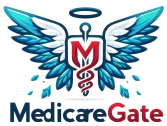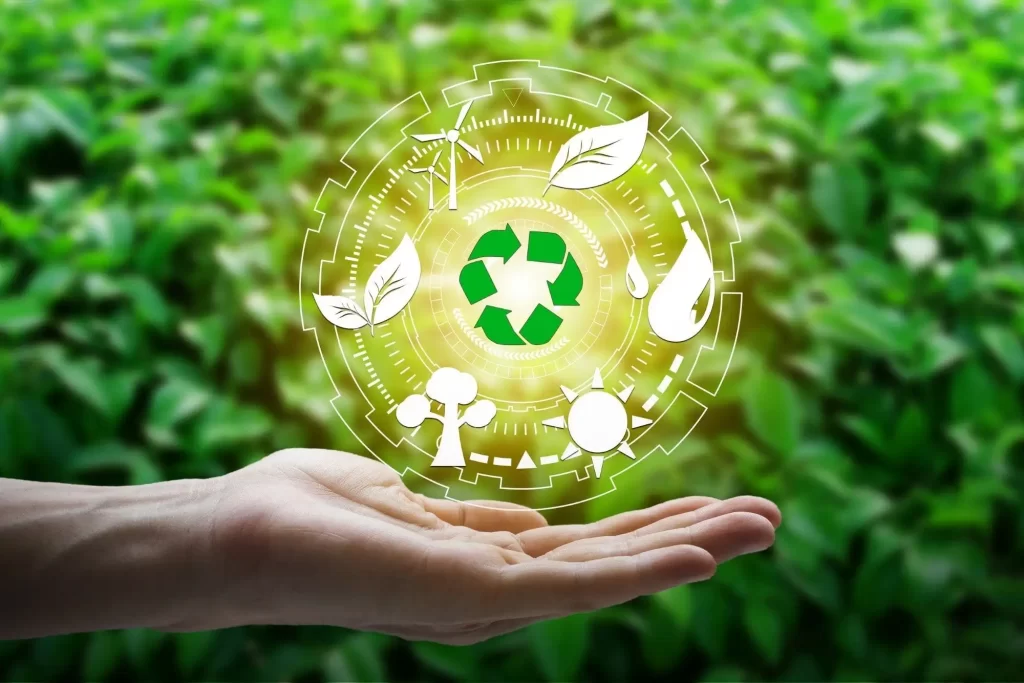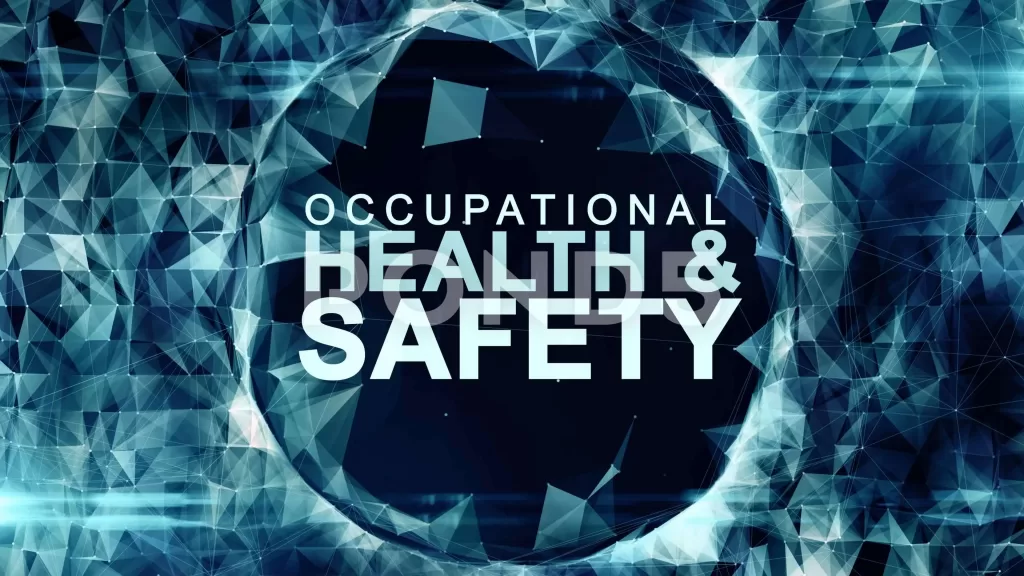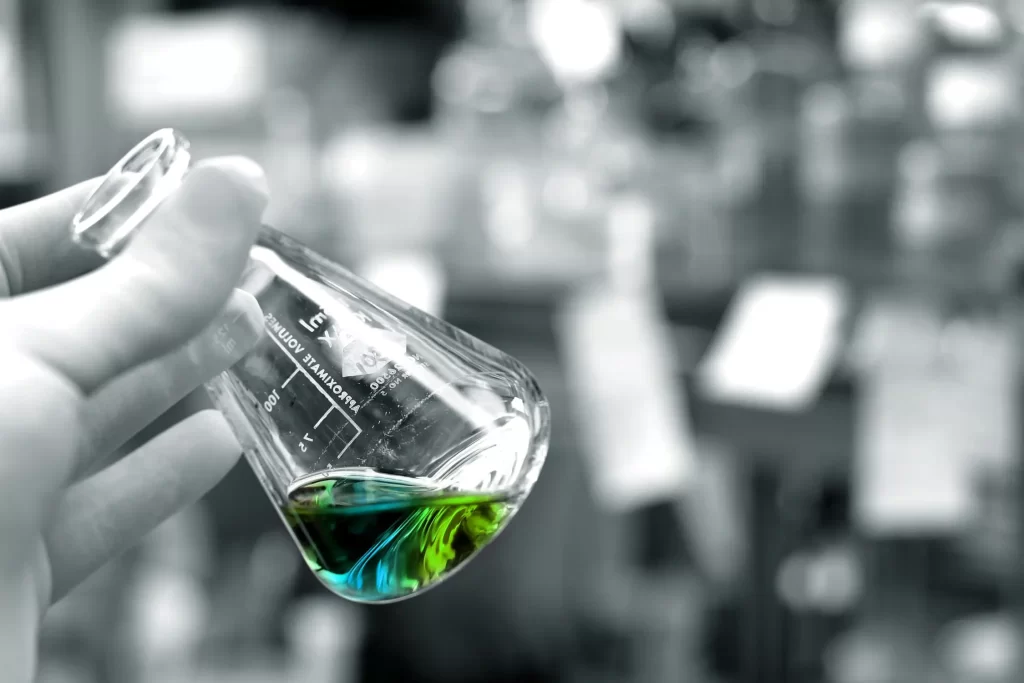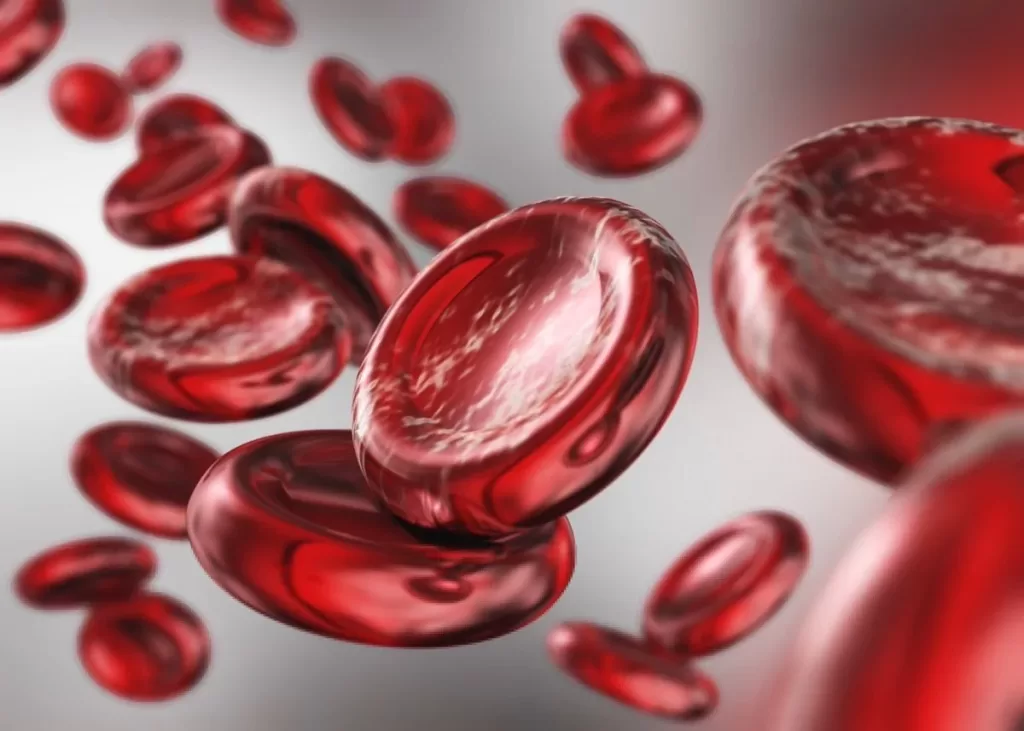Introduction
Biological hazards, also known as biohazards, are biological substances that pose a threat to the health of living organisms, most particularly humans.
This can include medical waste or samples of microorganisms, viruses, or toxins (from a biological source) that can harm human health.
Workers in the agricultural and fishing industries as well as in the health and community care sectors are particularly at risk of exposure to hazardous biological agents.
All workplaces have the potential for biological hazard exposure, particularly through the person-to-person transmission of infectious diseases.
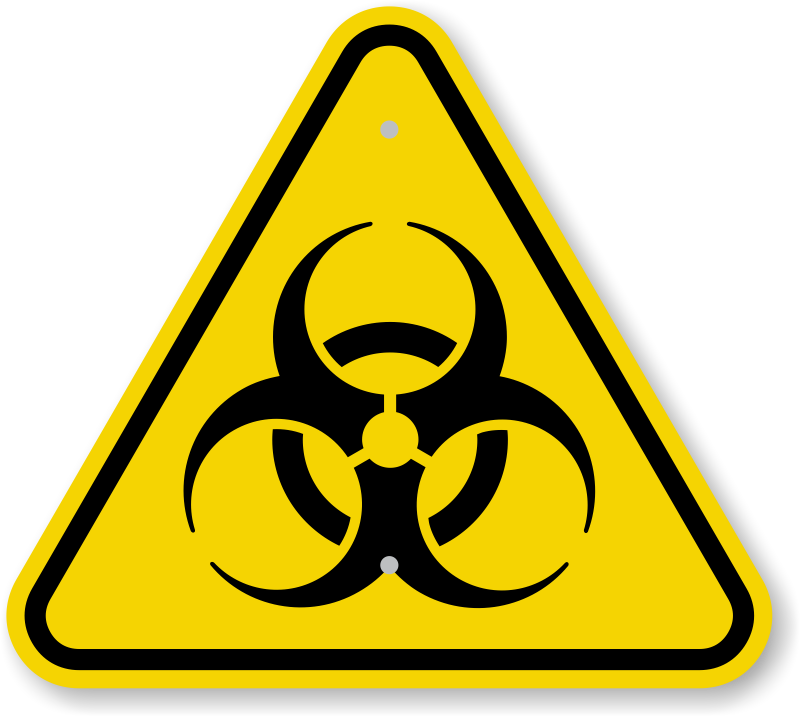
The standard biohazard symbol is meant to be evocative of danger, and was designed
to be memorable but meaningless so that people could be taught what it meant.
Biological Hazards
1. Human Tissue and Body Fluids
Blood-borne viruses and other agents could be present in human body fluids and tissue.
Therefore, handling human blood samples or tissue carelessly increases the risk of infection.
a. Routes of Exposure
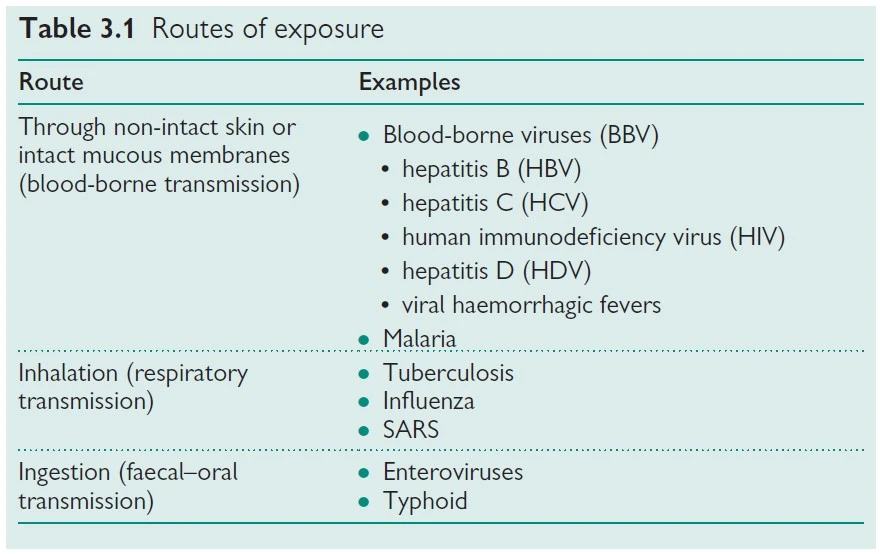
Routes of Exposure
b. Occupations at Increased Risk from Blood-Borne Viruses (BBV)
Healthcare workers (HCWs), in particular:
- Surgeons, theatre nurses.
- Dentists
- Midwives.
- Dialysis technicians.
- Ambulance technicians.
- Mortuary technicians.
- Laboratory workers.
- Chiropodists.
- Acupuncturists.
Police and firefighters.
Prison workers.
Social workers.
Military personnel.
There is a lower, but significant, risk among:
- Embalmers and crematorium workers.
- Cleaners.
c. Human Biological Material Associated with Transmission of BBV
- Blood.
- Synovial fluid
- Blood-stained fluid.
- Amniotic fluid.
- Pleural fluid.
- Breast milk
- Pericardial fluid.
- Semen.
- Peritoneal fluid.
- Vaginal secretions.
- Cerebrospinal fluid.
- Unfixed tissues and organs.
d. Risk Controls
Adherence to standard infection control procedures, including: –
- Hand hygiene.
- Use of personal protective equipment (PPE) (gloves for procedures that involve a risk of contamination.
- Double gloves for surgical procedures on patients known to be infected with (BBV).
- In areas where there is a risk of splashing, aprons, goggles, and masks are required, as well as boots or overshoes if the floor is contaminated.
Other Risk Controls Include:
- Avoid re-sheathing needles and use safer sharps devices.
- Proper disposal of contaminated waste and sharps.
- Proper specimen transportation.
- Filtering respiratory masks for aerosol-generating procedures.
- Immunization against influenza, TB, and HBV.
- Appropriate decontamination techniques for spills.
Quick response to contamination and sharps incidents (Management of needlestick and contamination incidents).
2. Microbial Pathogens (in Laboratory Settings)
Although microorganisms are a large and diverse class of organisms, only a small subset of them, known as pathogens, are responsible for causing disease.
There are four types of microorganisms that can interact with humans: viruses, bacteria, fungi, and parasites.
Pathogens can be hazardous to workers due to their widespread distribution in the workplace.
a. Common Sources
The majority of dangerous pathogen exposure at work occurs in clinical or experimental lab settings, frequently in the healthcare or veterinary fields.
b. Classification of Microbial Pathogens (according to COSHH Regulations)
HG 1 → Unlikely to cause disease in humans.
HG 2 → Possesses the potential to cause human disease, likely to be a hazard to workers, but unlikely to spread in the community and is treatable.
HG 3 → A hazard to employees, with the potential to spread to the community, but treatable.
HG 4 → Can cause serious illness in humans, a hazard to employees and the community with no available prophylaxis or treatments.
HG: Hazard Group
c. Risk Controls
Containment: three levels of containment for Hazard Group 2-4 pathogens, including:
- Separation from other activities.
- –ve pressure ventilation.
- High-efficiency particulate absorption (HEPA) filtered air intake and output.
- Only authorized personnel are allowed (e.g., access controls).
- Safety cabinet.
- Observation window for monitoring from the outside.
Use of PPE including respiratory protective equipment.
- Plans for emergencies and incidents (handling accidents).
- Vector control (rats mainly).
- Display biohazard warnings.
- Safe procedures for disinfection and decontamination.
- Managing waste safely.
- Safe pathogen transportation.
- Good hygiene: separation of eating areas for staff, hand washing routines.
Related: Physical Hazards in Occupational Health
3. Genetically Modified Organisms
Genetic modification (GM) refers to the deliberate manipulation of organisms’ genetic material (DNA or RNA) in ways that do not occur in nature.
The purpose of GM is to introduce new or altered characteristics to plants, animals, or, most frequently, microorganisms (bacteria, viruses, and fungi).
These modified characteristics can subsequently be transferred between cells or organisms.
a. Common Sources/Specific Industries
GM is performed in labs, animal houses, and plant growth facilities (referred to as “contained use”).
Those at risk of occupational exposure include:
- Laboratory workers.
- Animal house workers.
- Horticulturalists in experimental facilities.
b. Risk Assessment and Control
- Risk assessment for all activities involving genetically modified organisms (GMOs).
- A GM safety committee should be established to advise on risk assessments.
- Use of a four-level classification system based on the risk of the activity (this is based on the four levels of containment for microbial laboratories).
- Notification of all premises to HSE prior to their first use for GM activities.
- Notification of individual activities of Class 2 to Class 4 to the Competent Authority (administered by HSE).
- Maintenance of a public register of GM premises and certain activities.
- Laboratories should adhere to good containment and laboratory practices.
4. Animals and Animal Products
People who work directly with animals or are exposed to animal products are at risk of a wide range of biological hazards.
These occupations include: –
- Abattoir and meat workers.
- Animal handlers.
- Animal pound workers.
- Aviary workers.
- Customs officers.
- Police officers.
- Farmers.
- Graziers.
- Customs inspectors.
- Laboratory workers.
- Pet shop and quarantine
- Kennel personnel.
- Ranchers.
- Shepherds.
- Stockmen.
- Veterinarians.
- Wildlife rangers.
- Wool sorters.
- Zoo personnel.
Zoonoses are a group of infections that are usually found in animals as their primary hosts but which spread from animals to humans.
Some can be transmitted from human to human.
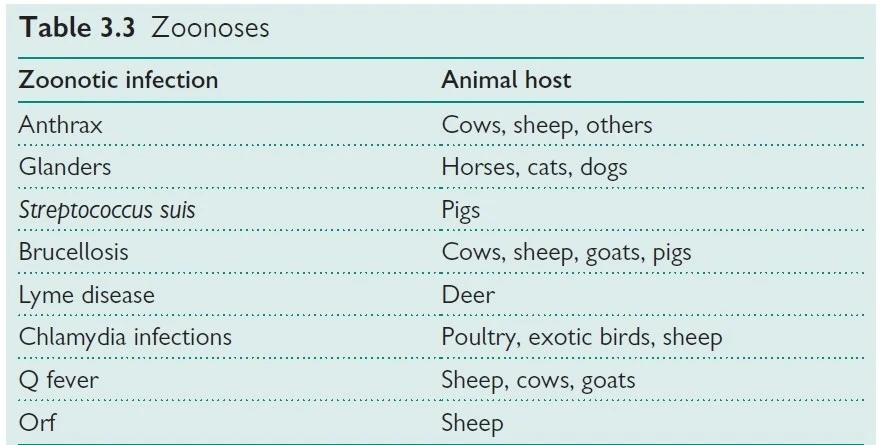
Zoonoses
a. Prevention/Exposure Control
Good husbandry practices for livestock:
- Good hygiene standards in young-stock housing.
- Low stocking densities.
- Avoid contaminating the drinking water of animals with dung.
- Keep animals as stress-free as possible.
Education and awareness of zoonoses:
- Inform staff members and visitors about the risks of zoonoses and how to take precautions.
- If any suspicious symptoms appear, consult a doctor immediately and declare animal exposure.
Identify those with individual susceptibility and restrict from exposure:
- Pregnant women (avoid pregnant sheep).
- Immune-compromised people.
Immunizing and treating livestock.
Good occupational hygiene practices.
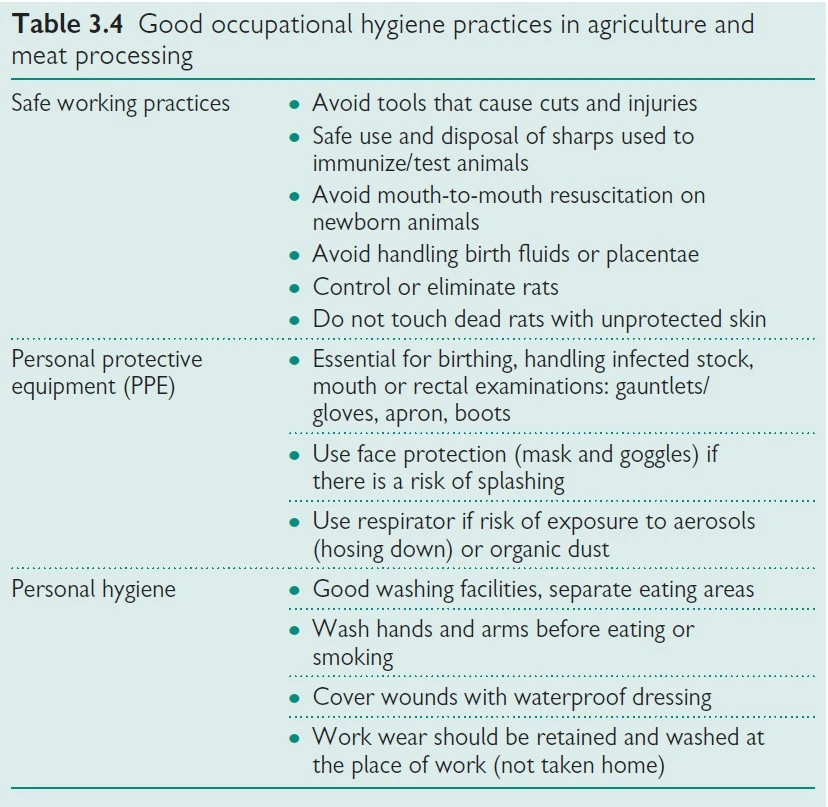
Good occupational hygiene practices in agriculture and meat processing
5. Organic Dusts and Mists
These are biological agents that can cause occupational disease and are widespread in the workplace.
They are primarily high molecular weight proteins derived from plant and animal material, as well as microorganisms.
a. Common Sources
1. Organic dusts
- Animal proteins:
- Urine and dander from farm or laboratory animals (e.g., cows, rats)
- Plant proteins:
- Natural rubber latex.
- Grain dust.
- flour dust.
- Wood dusts.
- Colophony.
- Microbial:
- Molds and spores that grow in the vegetable matter (e.g., hay, mushroom compost)
- Enzymes.
Read Also: Chemical Hazards in Occupational Health
2. Organic Mists
Proteinaceous mists produced by washing fish products, as well as surfaces or equipment contaminated with fish/animal proteins
Metalworking fluids contaminated with bacteria.
b. Industries at Risk
- Health care industry.
- Rubber manufacturing.
- Laboratories and animal houses/care facilities.
- Farming.
- Baking and flour milling.
- Biological detergent manufacture.
- Fish processing.
- Engineering.
c. Health Effects
Type I allergy (IgE-mediated):
- Occupational asthma.
- Allergic rhinitis.
- Contact urticaria.
- Anaphylaxis.
Hypersensitivity pneumonitis.
d. Risk controls
Minimize exposure: generic principles
- Good animal husbandry, which includes avoiding overcrowding.
- Good hygiene —regular cleaning of animal cages and housing, wood workshops, and bakeries.
- General and local ventilation.
- Dust abatement techniques: avoid using dry sweeping or compressed air lines for cleaning; instead, use an industrial vacuum cleaner or wet clean.
PPE can be used if a significant risk exists after appropriate exposure control efforts, such as for intermittent dusty tasks.
Some advocate the use of respiratory protective equipment (RPE) as a last resort for sensitized workers whose livelihood is dependent on working in ‘at-risk’ situations (e.g. farmers).
If this approach is suggested, it must be done with extreme caution and only after every effort has been made to reduce exposure.
The individual must be closely monitored (health surveillance) for signs of deterioration.
Summary
Biological hazards, also known as biohazards, are biological substances that pose a threat to the health of living organisms, most particularly humans.
This can include medical waste or samples of microorganisms, viruses, or toxins (from a biological source) that can harm human health.
Workers in the agricultural and fishing industries as well as in the health and community care sectors are particularly at risk of exposure to hazardous biological agents.
Biological hazards include: –
Human Tissue and Body Fluids
Blood-borne viruses and other agents could be present in human body fluids and tissue.
Therefore, handling human blood samples or tissue carelessly increases the risk of infection.
Microbial Pathogens (in Laboratory Settings)
Although microorganisms are a large and diverse class of organisms, only a small subset of them, known as pathogens, are responsible for causing disease.
There are four types of microorganisms that can interact with humans: viruses, bacteria, fungi, and parasites.
Pathogens can be hazardous to workers due to their widespread distribution in the workplace.
Genetically Modified Organisms
Genetic modification (GM) refers to the deliberate manipulation of organisms’ genetic material (DNA or RNA) in ways that do not occur in nature.
The purpose of GM is to introduce new or altered characteristics to plants, animals, or, most frequently, microorganisms (bacteria, viruses, and fungi).
Animals and Animal Products
People who work directly with animals or are exposed to animal products are at risk of a wide range of biological hazards.
Organic Dusts and Mists
These are biological agents that can cause occupational disease and are widespread in the workplace.
They are primarily high molecular weight proteins derived from plant and animal material, as well as microorganisms.
Read More Information About: Types of Hazards in Occupational Health
[ratemypost]
References
Elsevier. (2016). Biological and environmental hazards, risks, and disasters.
Sadhra, S. S., Bray, A., & Boorman, S. (2022). Oxford Handbook of Occupational Health. Oxford University Press.
Biological Hazards. (2019). From OHS Body of Knowledge.
Health and Safety Guidance Work with Human Body Fluids and Tissues GUIDANCE/26/WHBFT/14. (2014). From University of Birmingham.
